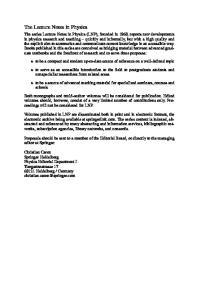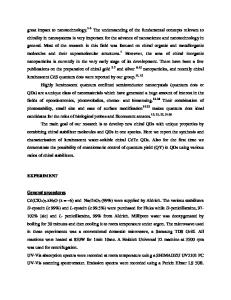Quenching Phenomena in Water-Soluble CdSe/ZnS Quantum Dots
- PDF / 103,256 Bytes
- 6 Pages / 612 x 792 pts (letter) Page_size
- 78 Downloads / 269 Views
QUENCHING PHENOMENA IN WATER-SOLUBLE CdSe/ZnS QUANTUM DOTS D.M. Speckman, T.L. Jennings, S.D. LaLumondiere, and S.C. Moss The Aerospace Corporation, P.O. Box 92957, Los Angeles, CA 90009 ABSTRACT Semiconductor nanocrystals are expected to play an important role in the development of novel electronic and optoelectronic devices, and have already shown promise in the area of biological reporters for medical screening and sensor applications. We have been involved in developing luminescent CdSe/ZnS core-shell nanocrystals (or quantum dots, QDs) for use in self-assembled structures and as fluorescent reporters in immunoassay-based biodetectors. As part of our efforts to bind semiconductor CdSe/ZnS quantum dots to antibody proteins for our immunoassay work, we functionalized the nanocrystal surfaces with a variety of organic acid salts to impart water solubility to the nanocrystals. During the course of working with these derivatized, water-soluble quantum dots, we observed significant differences in their chemical reactivities and physical characteristics compared to those of underivatized CdSe/ZnS nanocrystals. One of the most striking differences observed is the reactivity of the derivatized and underivatized nanocrystals with stainless steel surfaces. The fluorescence of aqueous mixtures of our water-soluble nanocrystals is immediately quenched upon exposure of the mixtures to stainless steel (SS) surfaces or to chromium oxide, whereas underivatized quantum dots exhibit little or no reactivity at all. As has been reported by several other laboratories, the water-soluble nanocrystals also exhibit significantly lower quantum yields compared to the underivatized nanocrystals. We discuss the unusual reactivity exhibited by these nanocrystals, and suggest possible explanations for their interesting chemical behavior. We also describe methods to prevent the quenching of water-soluble derivatized quantum dots by stainless steel and metal oxides. INTRODUCTION Semiconductor nanocrystals or quantum dots (QDs) have the potential to contribute to electronics and photonics applications such as sensors, switches, light-emitting diodes, data storage and manipulation, and photovoltaic devices. In order to be used successfully for applications such as these, nanocrystal surfaces must often be modified to alter their chemical properties and solubility characteristics. The manner in which different surface groups influence the optical and chemical properties of CdSe nanocrystals has been the focus of a great deal of research. However, the influence of surface groups on the optical and chemical properties of ZnS-capped CdSe nanocrystals, as well as the influence of solvent, has not been well studied. We have been developing luminescent CdSe/ZnS core-shell nanocrystals for use in selfassembled structures and as fluorescent reporters in immunoassay-based biological sensors [1]. As part of this work, the surfaces of CdSe/ZnS nanocrystals were functionalized with organic acid groups to impart water solubility. Following derivatization, we ob
Data Loading...








